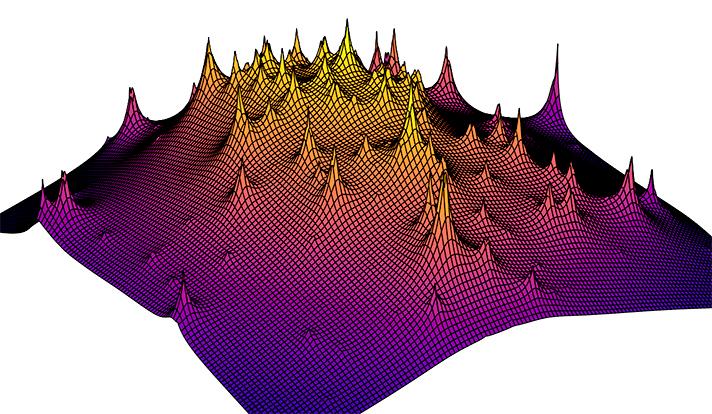Yale-led team puts dark matter on the map

This is a 3-D visualization of reconstructed dark matter clump distributions in a distant galaxy cluster, obtained from the Hubble Space Telescope Frontier Fields data. The unseen matter in this map is comprised of a smooth heap of dark matter on which clumps form. Credit: Yale University
The dark matter map is derived from Hubble Space Telescope Frontier Fields data of a trio of galaxy clusters that act as cosmic magnifying glasses to peer into older, more distant parts of the universe, a phenomenon known as gravitational lensing.
Yale astrophysicist Priyamvada Natarajan led an international team of researchers that analyzed the Hubble images. “With the data of these three lensing clusters we have successfully mapped the granularity of dark matter within the clusters in exquisite detail,” Natarajan said. “We have mapped all of the clumps of dark matter that the data permit us to detect, and have produced the most detailed topological map of the dark matter landscape to date.”
Scientists believe dark matter — theorized, unseen particles that neither reflect nor absorb light, but are able to exert gravity — may comprise 80% of the matter in the universe. Dark matter may explain the very nature of how galaxies form and how the universe is structured. Experiments at Yale and elsewhere are attempting to identify the dark matter particle; the leading candidates include axions and neutralinos.
“While we now have a precise cosmic inventory for the amount of dark matter and how it is distributed in the universe, the particle itself remains elusive,” Natarajan said.
Dark matter particles are thought to provide the unseen mass that is responsible for gravitational lensing, by bending light from distant galaxies. This light bending produces systematic distortions in the shapes of galaxies viewed through the lens. Natarajan's group decoded the distortions to create the new dark matter map.
Significantly, the map closely matches computer simulations of dark matter theoretically predicted by the cold dark matter model; cold dark matter moves slowly compared to the speed of light, while hot dark matter moves faster. This agreement with the standard model is notable given that all of the evidence for dark matter thus far is indirect, said the researchers.
The high-resolution simulations used in the study, known as the Illustris suite, mimic structure formation in the universe in the context of current accepted theory. A study detailing the findings appeared Feb. 28 in the journal Monthly Notices of the Royal Astronomical Society.
###
Other Yale researchers involved in the study were graduate students Urmila Chadayammuri and Fangzhou Jiang, faculty member Frank van den Bosch, and former postdoctoral fellow Hakim Atek. Additional co-authors came from institutions worldwide: Mathilde Jauzac from the United Kingdom and South Africa; Johan Richard, Eric Jullo, and Marceau Limousin from France; Jean-Paul Kneib from Switzerland; Massimo Meneghetti from Italy; and Illustris simulators Annalisa Pillepich, Ana Coppa, Lars Hernquist, and Mark Vogelsberger from the United States.
The research was supported in part by grants from the National Science Foundation, the Science and Technology Facilities Council, and NASA via the Space Telescope Institute HST Frontier Fields initiative.
Media Contact
All latest news from the category: Physics and Astronomy
This area deals with the fundamental laws and building blocks of nature and how they interact, the properties and the behavior of matter, and research into space and time and their structures.
innovations-report provides in-depth reports and articles on subjects such as astrophysics, laser technologies, nuclear, quantum, particle and solid-state physics, nanotechnologies, planetary research and findings (Mars, Venus) and developments related to the Hubble Telescope.
Newest articles

A universal framework for spatial biology
SpatialData is a freely accessible tool to unify and integrate data from different omics technologies accounting for spatial information, which can provide holistic insights into health and disease. Biological processes…

How complex biological processes arise
A $20 million grant from the U.S. National Science Foundation (NSF) will support the establishment and operation of the National Synthesis Center for Emergence in the Molecular and Cellular Sciences (NCEMS) at…

Airborne single-photon lidar system achieves high-resolution 3D imaging
Compact, low-power system opens doors for photon-efficient drone and satellite-based environmental monitoring and mapping. Researchers have developed a compact and lightweight single-photon airborne lidar system that can acquire high-resolution 3D…





















